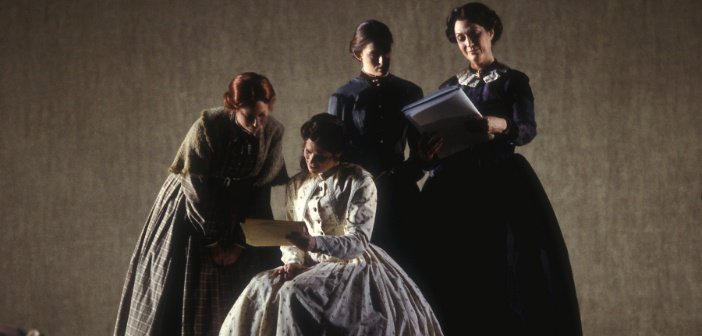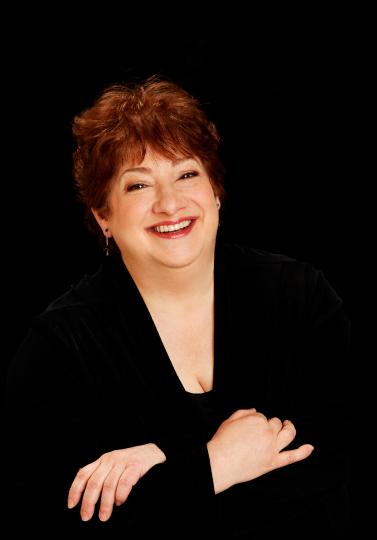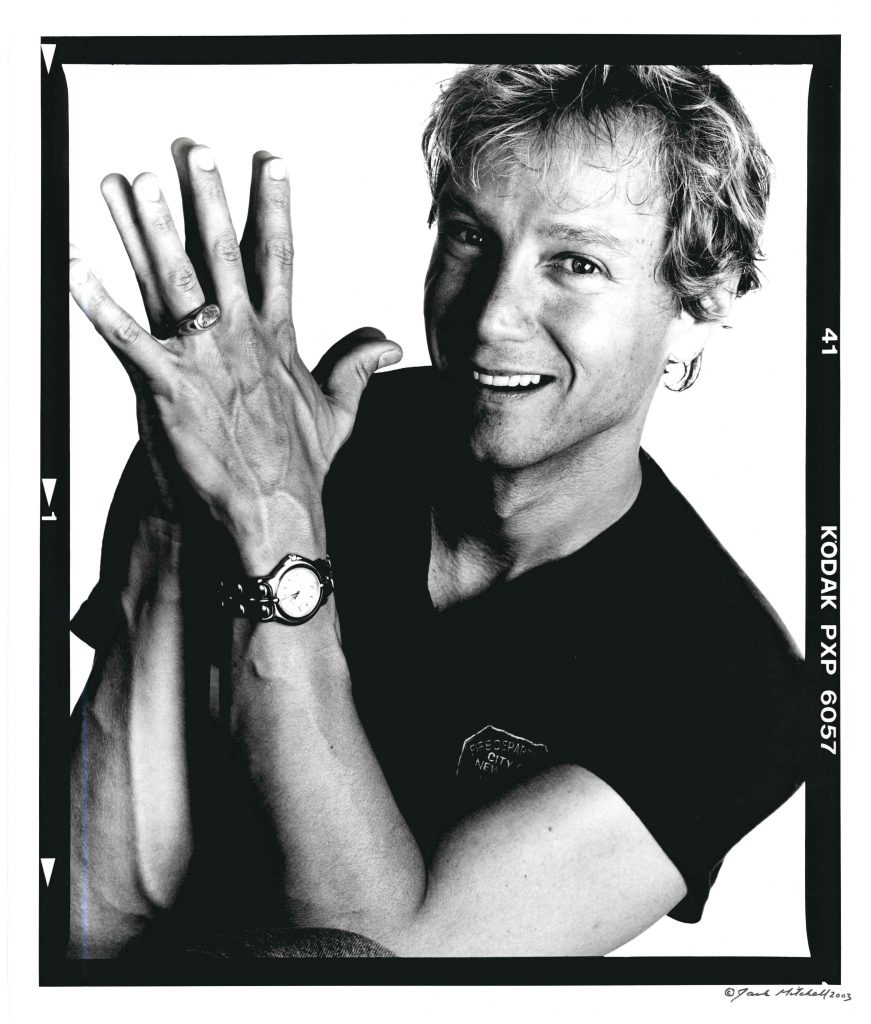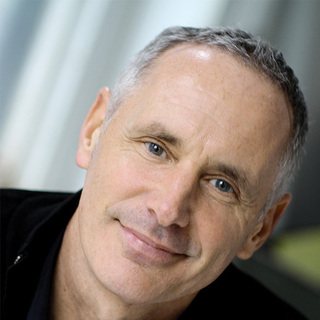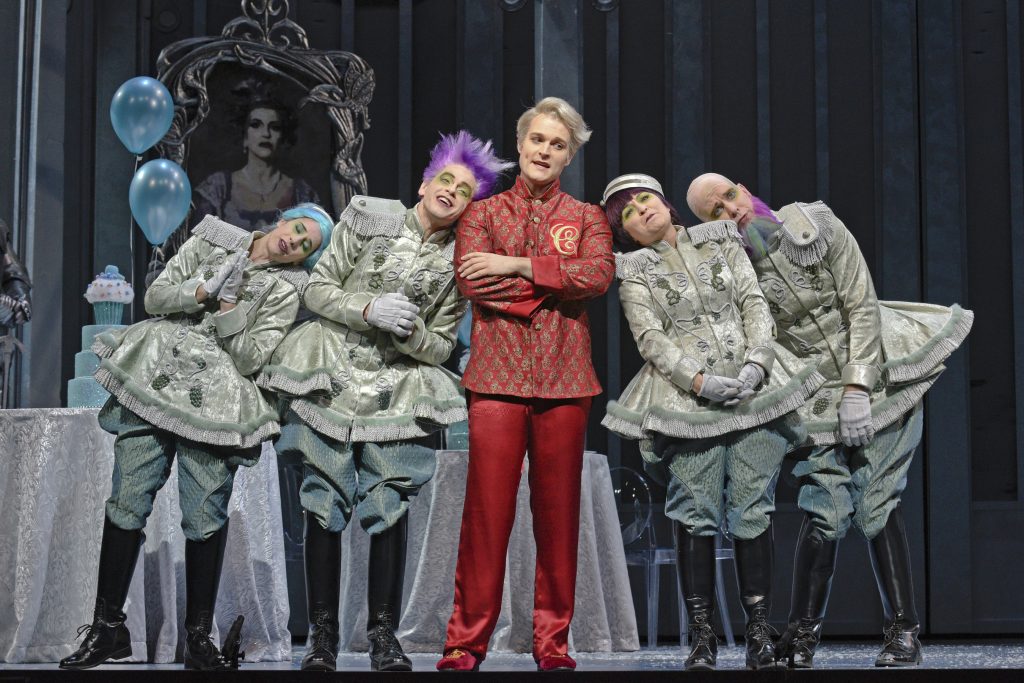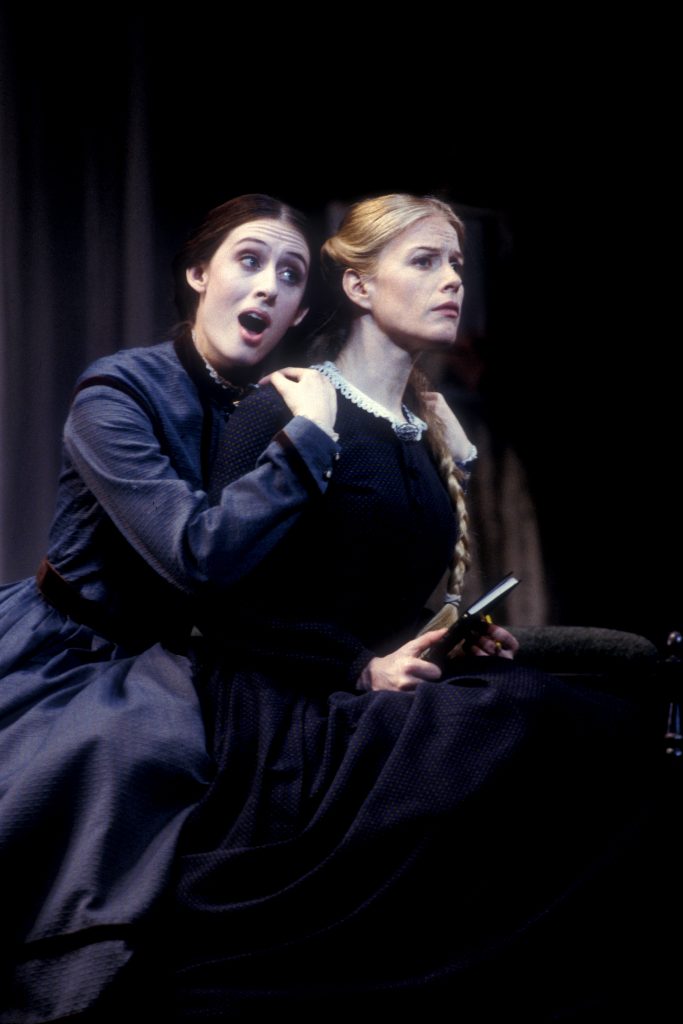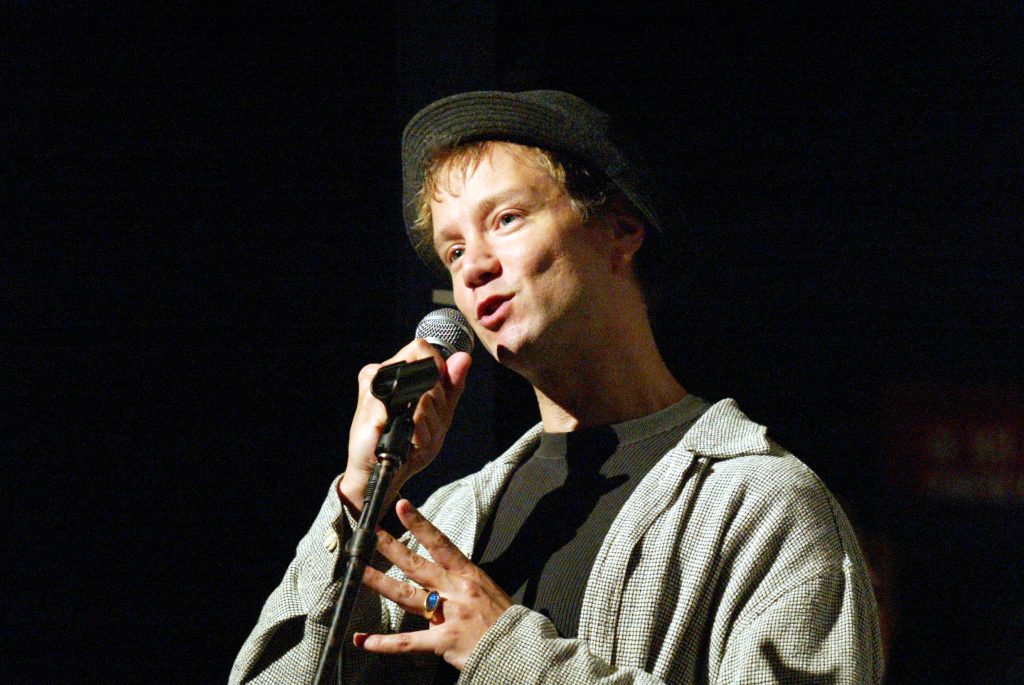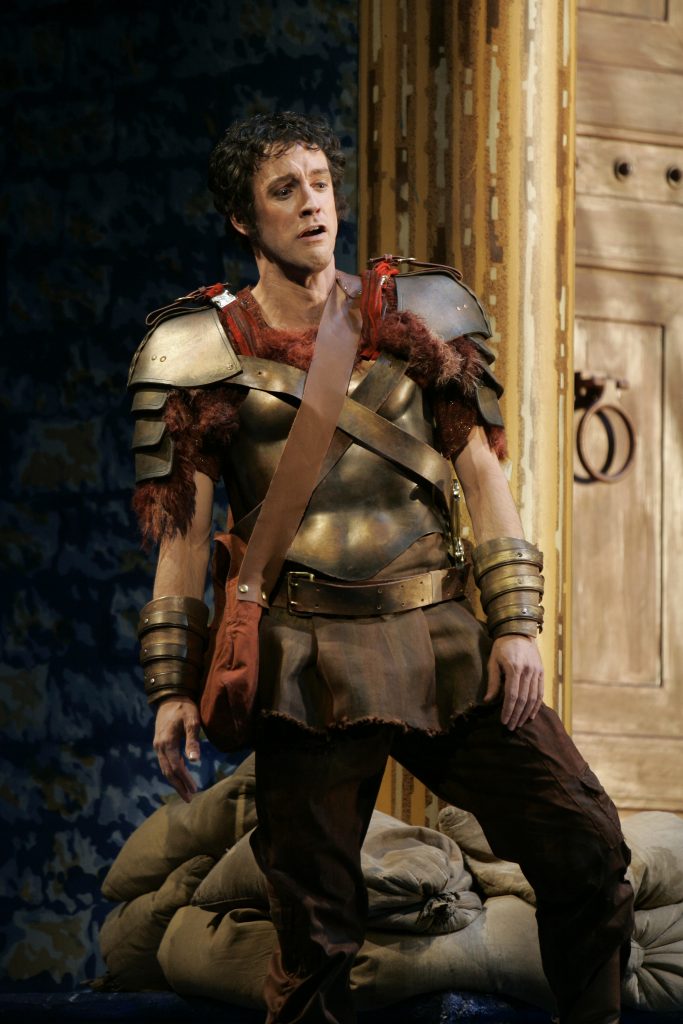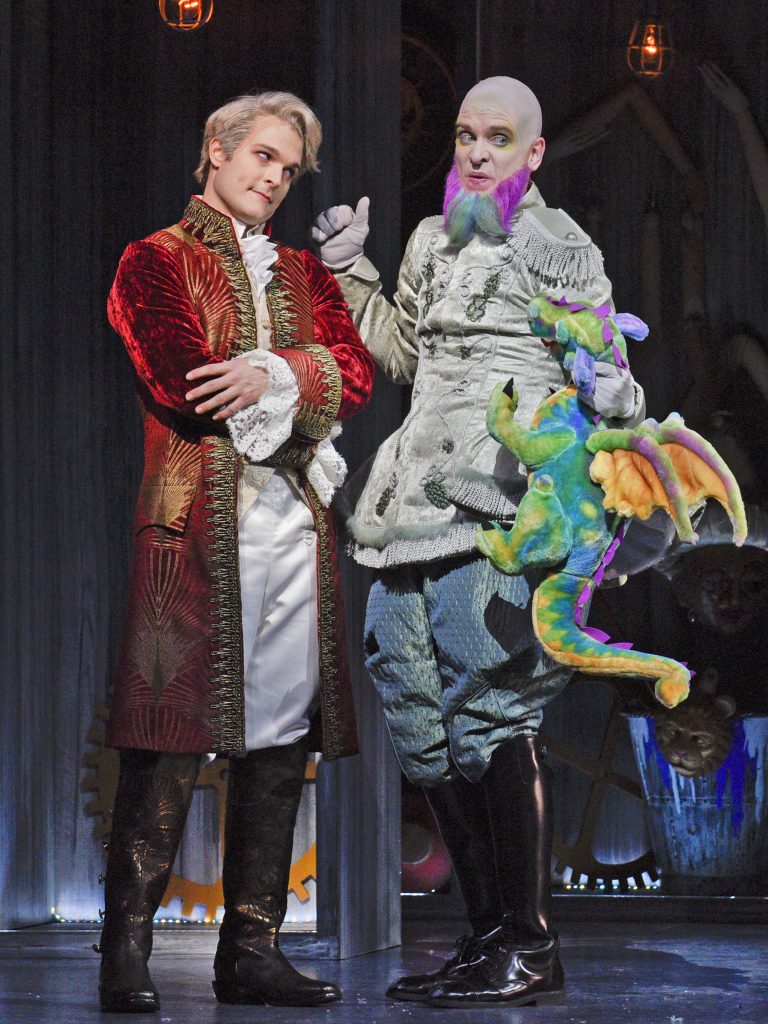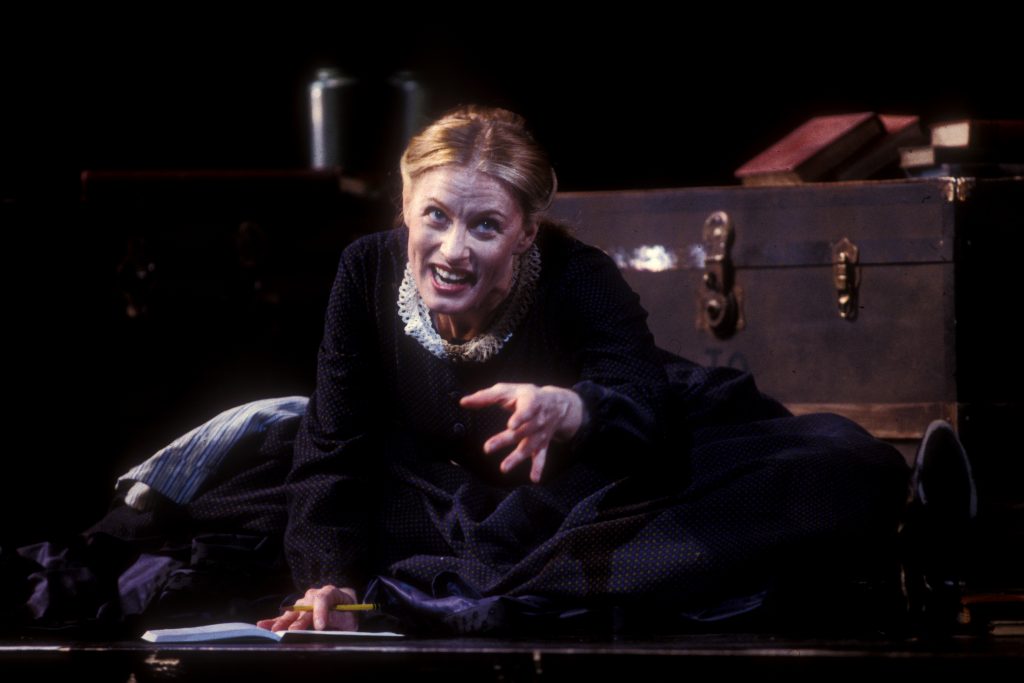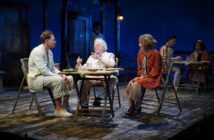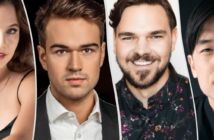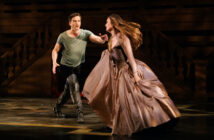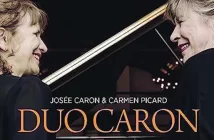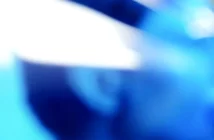Mark Adamo, in conversation with Charles Geyer
It started as an idea over drinks. It became a quest to “achieve everything.”
In 2002, Larry Edelson, then an assistant opera director completing his graduate degree at NYU, and Mark Adamo, the celebrated American composer-librettist of Little Women (one of the most oft-produced and critically lauded new operas of recent decades), were discussing – take a guess – American opera. Not how great it was, or how imperiled it was; not its funding nor its popularity – but something much more fundamental, and mysterious: Where it came from.
The opera field was vibrant enough, but there persisted an ab nihilo aspect to the origins of most new works. Why was really good new America opera so seemingly unpredictable, adventitious – and rare? Ball lightning rolling unbidden now and then across a dark landscape.
Maybe what was needed was a way to ensure that more composers and librettists actually had a solid set of skills for creating opera.
Talk turned to action, and the American Lyric Theater was born. And, through its central and signature operation – The Composer Librettist Training Program (or CLDP) – the institution has now been nurturing and, in a very real sense, making opera composers and librettists since 2007.
Sage Counsel
The CLDP faculty is topline. One of its mainstays is the ubiquitous opera dramaturge Cori Ellison, among whose myriad credentials is her position as the first-ever dramaturge of the estimable Glyndebourne Festival Opera. At the CLDP, Ellison teaches the history of opera’s evolving structural relationships between words and music; she shepherds participants through attendance at – and discussions after – a variety of opera rehearsals and performances around New York; she moderates masterclasses given by visiting artists; and she is ever on hand to propose solutions to the tangles and pitfalls of participants’ own unfolding operatic designs, able to retrieve helpful and apposite precedents from her vast mental store of the operatic literature.
Larry Edelson – ALT’s founder and (in the words of Cori Ellison) its “secret sauce” – has become one of the busiest and most distinguished opera directors on the contemporary scene, and is also about to present his third full production season as artistic director of Opera Saratoga. But Edelson is nonetheless deeply and indefatigably engaged in every aspect of ALT’s pedagogy, commissioning, development, and opera-company-relations activities.
Guest lecturers at past and future CLDP sessions include Anthony Davis (composer of X, The Life and Times of Malcolm X), who discussed operatic approaches to historical characters; Kaija Saariaho, who analyzed her own construction of her renowned opera, L’Amour de loin; John Corigliano; William M. Hoffman; Mark Campbell (who joined ALT faculty in 2012); Jake Heggie (a new CLDP faculty addition for the coming year); Nico Muhly – an elite, gilt-edged roster of contemporary operatic practitioners.
And then there’s Mark Adamo.
Go-To Guy
Adamo, with his gifts for analysis, Socratic provocation, and inspiration, represents the sine qua non of the CLDP experience. Boyishly exuberant, Adamo rouses classroom excitement via not only stimulating discourse, but an accompanying eloquence of ceaseless gesticulation; his arms, as mobile as the most rapt orchestral conductor’s, are frequently flung so wide as to seem to embrace the music of a continent.
Adamo also speaks brilliantly, fluently and quotably, outfitting his ideas in full syllogistic trim, yoking his own arguments to those that might fairly be ranged against them with a consistently even and keen Boolean precision.
“Let a thousand flowers bloom!” Adamo exclaims of the energy, variety and fecundity of the opera landscape today.
It is thus a privilege, in this first of a series of articles examining the unique and indispensable contributions of the American Lyric Theater to the advancement of American opera, to present the following Mark Adamo digest.
While formatted as a dialogue, this material is actually the fruit of a number of conversations and correspondences between the writer and Mr. Adamo and is, in essence, the makings of a living manifesto – fierce in its advocacies and desiderata for a future “everything” in American opera, yet generous and even humble in its appreciation for the broad range of approaches, personalities and (as Adamo puts it) “sensibilities” to be encountered among those toiling in the field.
Enjoy the voice of a master American opera thinker, maker and educator.
– Charles Geyer
CHARLES GEYER: All right, Mark Adamo, let’s begin with the present moment. Can you give me your take on where new American opera is today?
MARK ADAMO: There’s more energy in American opera now than there’s been in years. I would suggest that it started to percolate with the premieres, within four years of each other, of John Adams’ and Alice Goodman’s Nixon in China in Houston in 1987 and John Corigliano’s and William M. Hoffman’s The Ghosts of Versailles at the Met in 1991 – two radically different pieces which both pointed to radically new ways of singing the way we live now. And I think my own opera, Little Women, probably has a place in the conversation, too, if only because of its extraordinary record of revival – we’ve passed our hundredth production since 1998! – which proved that “the repertory” is not cast in concrete.
In fact, the pace with which new works are presented has only accelerated, as companies see that such work often appeals more strongly to audiences than the warhorses can. When I was with City Opera, my 2006 Lysistrata outsold our Carmen that same year. And, as recently as last year, Paul Moravec’s and Mark Campbell’s The Shining sold out its entire run at Minnesota Opera before it even opened! Dallas Opera is another a case in point. It used to be one of the most elegant museums of the masterpieces of long-ago-and-far-away. Yet, in calendar 2015, it presented no fewer than three world premieres: Jody Talbot’s and Gene Scheer’s Everest in January, Jake Heggie’s and Terence McNally’s Great Scott in September, and my own Becoming Santa Claus in December. Opera Philadelphia used to bank very heavily on productions of Puccini and Strauss at the glamorous Academy of Music. Now, under David B. Devan, they’re a festival, performing all over the city, and offering – besides, say, Rossini’s Tancredi – works such as Missy Mazzoli’s and Royce Vavrek’s Breaking the Waves, and, next September, Kevin Puts’ and Mark Campbell’s Elizabeth Cree.
This is the new normal!
CG: And the American Lyric Theater, with its “Composer Librettist Development Program,” occupies a big and increasingly vital place in fostering the quality and volume of such new American works. How did the ALT/CLDP idea originate – and just what is that idea?
M.A.: The idea was director Larry Edelson’s. As early as 2002, his brainchild was to devise a program that would give to writers what so many young artists programs were giving to singers – the ability to bridge the gap between graduate school and actual opera work. Academy composition programs, so often, privilege symphonic thinking over dramatic thinking. It’s possible to acquire an advanced degree and an extraordinary skill set and still be starting from zero when it comes to the craft of singing drama. So Larry’s idea was to teach composers and librettists not only how the profession works, but how the art works.
CG: So, the academic music institutions give opera composition a kind of short shrift? Why is that? Is it a qualitative judgment? An implied put-down?
M.A.: I don’t think the academy has borne a conscious animus against stage work so much as it’s merely misread it. The relative prestige of Debussy’s Pelléas et Melisande is a good example. It’s a lovely, special piece, but it embodied an idea that was, for a time, everywhere in Anglophone thought: the notion that opera should aspire to the condition of a Franco-German symphony, rather than (it was implied) the sweaty, vocally-driven mountebankery of the Italian tradition. The older idea of opera-as-drama was replaced with the idea that opera is whatever a principally-orchestral composer comes up with when [he or]she decides to write for the theatre. The real damage was to the ideal that opera could be at once orchestrally substantial and dramatically vital.
CG: So, if Debussy exerted an unfortunate influence on the academy and on criticism for a time, and pushed things in the wrong direction, who are the better models of combined orchestral and dramatic strength?
M.A.: Verdi progressed steadily from a vocal dramatist with a coarse but effective sense of the orchestra (“he just makes it sound like a big guitar!” his detractors sniped – and, early on, they were right) to become the composer of Falstaff. I would place Puccini’s orchestral thinking, in Turandot, beside Wagner’s and Ravel’s. Benjamin Britten was supremely poised as both an orchestral and a vocal dramatist. And no one asks whether The Ghosts of Versailles is orchestrally or dramatically driven. The answer is yes, both, gloriously.
CG: And you’ve obviously found your way toward a functional ideal of your own. What is the backstory of your training? What prepared you to create Little Women, or Becoming Santa Claus, or The Gospel of Mary Magdalene?
M.A.: I cobbled together my own education from various places. I’d acted and written plays as a child before getting my first piano at the age of 16. Then I entered NYU as a playwriting major and, alongside that work, improvised the beginning of a double major in composition. I finished my composition degree in Washington and started conducting and singing chorally, writing program notes, et cetera – all practices which, of course, ultimately fortified my opera composition. But they were not to be taught, or learned, in any one place – which was precisely the need that Larry had identified. How could you take artists who already knew something about writing and composing, and give them the tools to develop those skills specifically for the stage?
CG: And your own involvement in the ALT, and in the structuring of the CLDP, can’t be underestimated. You were involved virtually from the start, were you not?
M.A.: Larry was finishing his graduate degree in arts administration at NYU, and in the summer of 2002 was working as an assistant director on Little Women at Glimmerglass – a production that subsequently travelled to New York and then Tokyo. He’d read an Opera America course outline that I’d created about Little Women, in conjunction with the opera’s four(!) productions in 2002/2003, and he felt that that course crystallized everything he’d want other artists to learn.
“I’d love a class like the one you’ve written to be the center of a curriculum,” Larry said. “If I can pull this thing together, will you teach?”
Well, I was thrilled to accept. No one had ever tried what we’d be trying – we’d be inventing the wheel! I came up with the “Gestus Outline” based on the Little Women course, and it’s still the central course of the CLDP, and probably proportionately involves the most class time.
CG: What is the “Gestus” approach and how did you come up with it?
M.A.: Candidly, I devised it as much out of fear as anything else, in writing Little Women. The sheer size and depth of even a small opera – the thousand ways you could get it wrong – made me want to look from as many angles as possible to solve what I really think has always been the central problem of opera – whether for Gluck or Wagner or ad nauseam: “prima la parole o prima la musica?” Or, as I couched it for myself: “How do you identify the core of the opera; the thing to which both music and words pertain and yet is neither music nor words – the trellis on which both music and words could grow equally?”
CG: So, it’s been the same problem throughout history? Or is it different for an American composer today?
M.A.: Well, we’re now in our second century of what I call cinematic perception. We listen more quickly, and get more from less. Our understanding of dramatic tempo has changed, and theatrical imagery now informs us as – if not often more – eloquently than words. All of which has upped the stakes for new opera as well. Even the timbral and motivic plot of an opera score, I thought, needs to move in a way that matches the way we see, and learn, today.
So I came up with what I called either a “silent movie” outline, or a draft of the choreography of an imagined narrative dance. It turned out to be a thrillingly useful tool to build a show so that neither the music nor the words would be either dragging or pushing the other. That outline is what I adapted as a teaching tool for CLDP.
CG: You’re both a composer and a librettist yourself. Traditionally, the composer of an opera gets most of the glory. What do you teach about the librettist’s role?
M.A.: You used to find (though, thankfully, less and less often) the kind of thinking that opera is music! music! music! and the words exist mostly as a kind of peacock feather, there to tickle the composer into composing. But read the correspondence of every major creator in the form. Read Verdi’s relentless oversight of his librettists Piave and Boito, particularly of the Shakespeare operas (and who sets Shakespeare if you care not for the language?). Remember Verdi’s famous description of the rôle of Lady Macbeth, which should be – and I quote – “more spoken than sung,” even in the arias; or his telling Boito that the music in Macbeth was meant “to serve the poet rather than the composer.” It’s true that we’ve had a less robust tradition of English-language opera in the 20th Century to draw from (I’m sure many more people knew Verdi’s operas in his time than anyone knows Jake Heggie’s or mine in our own). Still, our ancient and international legacies can teach all of us if we seek them out.
The more durable tradition has always held that, in opera, the music makes a theatrical experience intelligible in sound – an achievement impossible without an artist as librettist. Britten, for instance, was also extremely rigorous in his choice of libretti, but Ronald Duncan let him down with the libretto for the Rape of Lucretia and Britten never spoke to him again.
CG: The English-language opera tradition may not rival Italy’s or Germany’s, but, surely, at least so far this century – as you noted – it’s going strong.
M.A.: That’s why I always laugh when I hear, still, the canard, “Well, English can’t really be set; you can’t really sing opera in English.” I think, “There’s all this evidence to the contrary! If only we get out of our silos once in a while….”
CG: And there’s always Sanskrit as an alternative. I’m reminded of a remark you made about Stephen Sondheim, during one of our earlier conversations….
M.A.: Yes, we were having entirely too much fun! The only thing missing was the last Martini and the bartender looking at his watch.
CG: Make mine another Old-Fashioned, please! But about Sondheim?…
M.A.: Sondheim, in Look, I Made a Hat, advised – seriously or cheekily, it’s hard to tell – that all opera libretti should be written either entirely or partially in Sanskrit, because it’s a wonderful language insofar as (a) no one understands it and (b) it’s all vowels, so you can concentrate just on the music and the singing, which is all the opera audience really cares about anyway. The only thing I’d ask in response is: which parts of the libretti of Peter Grimes or Porgy and Bess would be improved by translation into Sanskrit?
CG: Another vodka stinger! But back to librettists…. Let’s get more specific about what you try to impart to them. I understand, for instance, that you encourage librettists to study and appreciate American song form, which might actually surprise a lot of opera purists.
M.A.: One of the reasons I’m so intent on exposing my student-librettists to the best lyrics from the American musical theatre is that intelligible melody depends very much on the symmetry and stresses of words – that is to say, on the skills that help build, in words, a creditable song. The easy rebuttal is to dismiss such technique as a Broadway (i.e. crass and commercial) thing. Rhyme! And yet: Carmen rhymes. La traviata rhymes. And – wait for it – Tristan und Isolde rhymes! These techniques exist to make language musical, not to render it unserious. Considering how readily, in the age of Google, one can discover these data, it’s amazing to me how surprised many people are when they learn that the texture of the script of La traviata is much closer to the book and lyrics of Sweeney Todd than it is to, say, the text of Written on Skin.
CG: You mention melody. There seems to be a feeling among some composers that to be taken seriously they must avoid writing anything that could be construed as “melodic.” I’ve actually spoken to composers who feel that melody must at least be hidden or disguised, “embedded in a cloud of dissonance,” lest it prove an embarrassment. What do you make of that?
M.A.: Yes, people often speak of melody in almost political terms: Do you write melodically, or do you not? We risk throwing out so many lovely babies with the bathwater by politicizing melody, and it grieves me. I’ve experienced it with my ALT students. When you ask them to write melody, they often have no idea how to start, how to work on this small scale. (Contrarily, while there are any number of orchestral or other skills that theatre songwriters do not have, they do often come in with this tool.)
Melody’s questions are artistic, not political or commercial. Thankfully, I think that the time has well and truly come and gone that we think “Oh my gosh, if you’re writing something this mnemonically available, you must be trying to score a place on the next Celine Dion album!” Please.
To make a melody requires skill. Adam Guettel [composer of The Light in the Piazza], memorably, calls melody “a packet of information.” Listen to the first four notes of Beethoven’s Symphony No. 5, then to the metrical and harmonic transformation of those four notes into something utterly different by the last movement. The power of that change can’t be fully explained by extra-musical metaphors, like “Fate knocking at the door.” It owes much more to Beethoven’s choice, and exposure, of his “packet of information” – those four notes, in a short space of time. This is melodic thinking at its acme.
On the other hand, I have found that no matter how clear you may think you’re being melodically, you’re almost never clear enough. Sondheim spent the first 20 years of his career being damned as unmelodic. Or, case in point – in the very same production of my own Little Women (which was reviewed very positively by The New York Times), one reviewer described a carefully tuneless modern opera that nonetheless worked beautifully, while another claimed that I had written a lovely opera, though I did club the tunes to death. These were both positive reviews! Yet one reviewer heard no themes; the other heard nothing but.
CG: So, if melody is liberated again, what about contrapuntal and harmonic practices? They’ve been pretty politicized in their day, too. I’m thinking, for instance, of the history of serial composition, the 12-tone row, et cetera.
M.A.: Schoenberg once described the 12-tone row as not simply a way of organizing harmony, but an “escape from the tyranny of the tonic note.” Which, in a way, is moving. If I had lived through his history, I too would have been looking for an escape from it, particularly when you consider that Germany had so defined itself by its culture in general and its music in particular. And if you felt that the political experiment to which your past tradition was allied was now discredited and in flames – absolutely, I too would want to build something from scratch.
CG: Not to mention the displacement of being Jewish.
M.A.: Agreed. The mistake was thinking that this German crisis needed to be an American one. 12-tone music probably could have come from nowhere else but Germany. The problem was thinking that because this was a specifically German solution to a specifically German problem, everybody around the world should be dealing with the same angst. But America had had no Wagner – we were building our concert tradition from different sources.
CG: Then there’s the counter-impulse – neoclassicism. Does that kind of recourse to the practices and forms of the classical past have a place in new opera, do you think?
M.A.: Neoclassicism, as an approach, was a moment that lasted maybe thirty years among certain Russians and Americans. There are masterpieces: The Rake’s Progress is one; Harold Shapero’s Symphony for Classical Orchestra, another. It could recur, but I think its moment has passed. It was revolutionary at the time insofar as it dared to look back, albeit ironically, at a time when musical thinking was almost maniacally focused on the future—and who could blame its artists, when the cataclysm of World War I seemed, so definitively, to have destroyed the past? Today, we feel freer to use history as well as life in making art. A better example of how we use history now is John Corigliano’s The Ghosts of Versailles. Its neoclassicism comprises only about a third of the score. John used not so much “wrong-note Handel,” a la Stravinsky, but affectionate quotation (if slightly skewed) from Mozart, and played it opposite these experimental, quasi-aleatoric textures that sounded orchestrally as wild as anything he’d ever done. His idea was to use contrasting idioms in that score the way older composers would use contrasting themes. In a very small way, I took a similar approach in Little Women. “Kennst du das Land?” was very much composed with Brahms on my shoulder; but I wasn’t assuming an attitude towards the character. I was trying to write the aria as if he – a German scholar with a reverence for the great tradition – had written it.
CG: So what might we say is the bottom line for compositional style in opera today? Is there, in your thinking, some essential American stylistic approach or model that can be articulated?
M.A.: Porgy and Bess, as a model, is so exciting because you see very clearly the eclecticism, the all-encompassing generosity of its musical conception. Some numbers would not be out of place in a 30s musical: “There’s a boat dat’s leavin’ soon for New York”, “It ain’t necessarily so.” Yet “Bess, You Is My Woman Now” could stand honorably beside Strauss. Berg would be impressed by the storm music. It’s so aesthetically American: it’s absolutely inconceivable without an immigrant sensibility. “What do you, O German Twelve Tone Row … what do you, O French Whole-Tone Scale … what do you, O Blues Spiritual, bring to the table? Let’s all meet and make an opera together.”
CG: It’s interesting that you proffer Porgy and Bess as a model, a work that stands equally in relation to that other great American genre, the Broadway musical, no? Is it relevant, anymore, to talk about categorical distinctions between the musical and American opera? Is it even possible?
M.A.: Sondheim says that what changes is the expectation of the audience. If you do Carmen in the opera house, it’s an opera. If you do it in a theater … But Carmen – and Porgy and Bess, for that matter – were originally produced in theatres, with their recits spoken. Die Zauberflöte was a Singspiel.
Sondheim said of certain big ‘80s musicals – Les Miserábles, Miss Saigon – that they weren’t exactly through-composed, but through-sung: which was his delicate way of noting that those scores are simply not as well-wrought as something like Porgy is. But witness the recent Porgy and Bess. It was adapted into a musical.
I think the most substantial observation to be made is that you will find motivic thinking of a symphonic kind often in the opera house and very seldom in the musical theater. And yet an eloquent rebuttal to that is Sondheim’s own Merrily We Roll Along, which texturally is a book-with-songs musical, while motivically it’s tighter than Götterdammerung! Yes, it’s all done in song form – the A strophe of one number becomes the B section of another, et cetera – but the structure is everywhere audible.
CG: I’d also observe that numerous musicals in recent years have begun sounding and feeling much more like opera, wouldn’t you say? Do you think, in some quarters, there’s almost a fetish about making musicals sound “operatically serious”?
M.A.: Fetish is the wrong word. I have been struck by how often, these days, in the work of some recent composers – Adam Guettel is one, Michael John LaChiusa is another – you hear the kind of extended musical paragraphs that, to me, characterize opera. And I loved them! I was just surprised.
CG: I have to assume, Mark, that as broad as your appreciation for various styles and various approaches is, there are works you don’t like. Is there, do you think, new work that fails the American operatic enterprise in some fundamental way?
M.A.: Well, I think it’s worth noting that my way is not the only way to do opera. It happens to be the way that I believe in, so it’s the thing I teach best. But we can’t exclude sensibility from this discussion.
There’s an entirely distinct tradition that doesn’t bother with narrative. You see Einstein on the Beach, or many other Glass operas, often described in the language of “meditation” or “vocal ballet.” Lovely. Makers of non-narrative art should not be chased with pitchforks. I do wonder, though, if they risk lowering the expectations of an audience, setting them up for what I’ll call the Higher Boredom – taking a form that can do, and has done, so much more, and reducing it to 1/100th of its potential. We’re always asking, “What can opera do? Is it relevant?” I don’t think it’ll be more relevant if we shrink it. My ideal is a piece that would make such a compelling and immediate case for the power of singing a story that someone who’d never heard of the form would exclaim “If this is what opera is, sign me up!” And I’m not entirely sure that the non-narrative pieces can do that as strongly.
Now, the rebuttal to that is, “Why must I be an ambassador for the form? Why must I write somebody’s first opera?” Or, “This is the case I’m making – that contemporary opera isn’t Tosca, with the melodrama and the knife and the candles!”
I do alert people that “you’re coming in and it’s my class.” I.e., my strengths, inevitably, will be my limitations. I have spent my entire mature artistic life thinking about these things I believe in, and have had evidence that they produce vital work. But I’m never happier than when students challenge me! I’m not trying so much to shut down a conversation as to develop it; to give students more specific questions by which they can forge their own paths. Not just questions like “How long is it to be? How many instruments do I have?” which are important practically, but “What am I doing, and why?” which comprise the art of what we do.
CG: So, ALT’s Composer Librettist Development Program has a lot of heavy lifting to do. Do you think there’ll be a time when the academy becomes enlightened, and starts pulling its own weight in fostering future opera creators?
M.A.: Historically, the academy follows, rather than leads, culture – and rightly so! The word “conservatory,” after all, comes from the verb “to conserve.” But students know where the future lies. At Juilliard, there’s now, in its first year, a student-led opera lab in which composers, singers and directors are working together to build scenes of their own – an ad hoc ALT, if you will. I wouldn’t be surprised if, in a few years, Juilliard offered a masters’ degree in composition with a specialty in stage work. I’d love to see that, at that school or anywhere. My intermittent frustration with ALT, which Larry knows, is that our program really should be a two-year masters’ program: I could design its curriculum tomorrow. But we live in an economy as well as a culture.
Sometimes I wonder if the best thing that could happen to us would be to become obsolete, because new programs would grow to do what we do. On the other hand – while it’s not an apples-to-apples comparison – neither the Lindemann program nor the Houston Opera Studio has made the “Master of Music in Vocal Performance” degree obsolete. At least right now, there’s a need for both.
CG: What, finally, is your ideal for the future America opera project writ large? The goal toward which you strive – and toward which you encourage CLDP’s participants to strive?
M.A.: Virgil Thomson wrote, concerning the wide variety of musical techniques available to us (in the 1950s!) that, “Everything is OK as long as it is enough so.” If a music is to be simple, make it really simple (but not simplistic); if it’s to be complex, make it really complex (not just busy).
I want a libretto as interesting as the most interesting contemporary play, and I want music as interesting as the most contemporary instrumental work. And at no point should you feel that one is dragging or pushing the other along. I’m arguing not for either/or but for both/and. The magic – the goal – is to achieve everything: a score that could work as a tone poem with the contours of drama; and a libretto in which you can hear music even before a note is composed.
This is what I try to train artists to make.
______________________________________________
The American Lyric Theater will initiate the sixth cycle of its Composer Librettist Development Program in September 2017; formative opera composers, librettists and dramaturges interested in being considered for participation in the CLDP may apply currently, through March 31, 2017 only. Application material can be found here.

